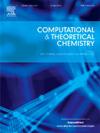What drives enhanced chloride recognition of squaramide-based receptors over urea and thiourea? A computational exploration in the gas-phase and various solvents
IF 3
3区 化学
Q3 CHEMISTRY, PHYSICAL
引用次数: 0
Abstract
Significant progress in anion recognition has been achieved through the development of synthetic receptors. Urea-, thiourea-, and squaramide-based molecules, known for hydrogen-bonding capabilities, have gained prominence in supramolecular chemistry. The superior anion recognition of squaramide-based receptors, compared to urea- and thiourea-based ones, is repeatedly attributed to the crucial involvement of C![]() H fragments. This study computationally investigates chloride recognition by nine symmetric urea-, thiourea-, and squaramide-based receptors, focusing on solvent effects, interactions, and intrinsic affinity. The findings suggest that while C
H fragments. This study computationally investigates chloride recognition by nine symmetric urea-, thiourea-, and squaramide-based receptors, focusing on solvent effects, interactions, and intrinsic affinity. The findings suggest that while C![]() H fragments aid anion recognition in squaramide-based receptors, the absence of steric repulsion and the presence of attractive forces between amide NH groups in squaramide, unlike in urea and thiourea receptors, significantly enhances anion-binding ability. Although solvation energy becomes less favorable from urea to squaramide, negative gas-phase Gibbs free energy drives complex formation. The accuracy of computational results is validated by excellent correlation between experimental and calculated formation constants.
H fragments aid anion recognition in squaramide-based receptors, the absence of steric repulsion and the presence of attractive forces between amide NH groups in squaramide, unlike in urea and thiourea receptors, significantly enhances anion-binding ability. Although solvation energy becomes less favorable from urea to squaramide, negative gas-phase Gibbs free energy drives complex formation. The accuracy of computational results is validated by excellent correlation between experimental and calculated formation constants.

是什么促使基于方酰胺的受体比尿素和硫脲更能识别氯化物?气相和各种溶剂的计算探索
通过合成受体的开发,阴离子识别取得了重大进展。以氢键能力著称的尿素、硫脲和方酰胺为基础的分子在超分子化学中获得了突出的地位。与基于尿素和硫脲的受体相比,基于角鲨酰胺的受体具有优越的阴离子识别能力,这一再归因于CH片段的关键参与。本研究通过计算研究了九种对称的脲基、硫脲基和方酰胺基受体对氯离子的识别,重点研究了溶剂效应、相互作用和内在亲和力。研究结果表明,虽然CH片段有助于角酰胺受体中的阴离子识别,但与尿素和硫脲受体不同,角酰胺中酰胺NH基团之间不存在空间排斥力和吸引力,从而显著增强了阴离子结合能力。虽然从尿素到方酰胺的溶剂化能变得不那么有利,但负的气相吉布斯自由能驱动络合物的形成。地层常数计算结果与实验结果具有良好的相关性,验证了计算结果的准确性。
本文章由计算机程序翻译,如有差异,请以英文原文为准。
求助全文
约1分钟内获得全文
求助全文
来源期刊

Computational and Theoretical Chemistry
CHEMISTRY, PHYSICAL-
CiteScore
4.20
自引率
10.70%
发文量
331
审稿时长
31 days
期刊介绍:
Computational and Theoretical Chemistry publishes high quality, original reports of significance in computational and theoretical chemistry including those that deal with problems of structure, properties, energetics, weak interactions, reaction mechanisms, catalysis, and reaction rates involving atoms, molecules, clusters, surfaces, and bulk matter.
 求助内容:
求助内容: 应助结果提醒方式:
应助结果提醒方式:


